By Madelene Knaggs, New Windsor Master Gardener Volunteer
This article appeared in the February 2021 Issue of Gardening in Orange County.
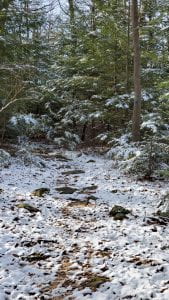 Not so fast with swapping out your hiking boots. Don’t let plunging temperatures lure you into packing away trusty outdoor gear just yet. Some of our region’s most loved trails offer a completely different hiking experience come wintertime. Put on some wool socks and get your dose of snow-dusted evergreens.
Not so fast with swapping out your hiking boots. Don’t let plunging temperatures lure you into packing away trusty outdoor gear just yet. Some of our region’s most loved trails offer a completely different hiking experience come wintertime. Put on some wool socks and get your dose of snow-dusted evergreens.
With snow and freezing temps, the Hudson Valley is known for its winters that drive most people to hibernate indoors. While those folks are cuddled up next to the fire sipping hot cocoa, there are inviting trails, mountaintops, and waterfalls just waiting to be discovered by winter enthusiasts. It may be chilly, but the rewards are well worth it.
Winter hiking can present its own set of challenges. Before you head out, think ahead and prepare for a wide range of conditions. Here are some tips to help you stay safe out on the trail:
-
- Make sure someone knows where you are going, and
never go out alone. - Visibility can be reduced due to shorter daylight hours as
well as blowing snow. - Carry a map (not just a digital device, which depends on
battery power and signal reception), compass, and
flashlight, as well as safety items such as matches and a
whistle. Pack a knife or multi-tool and a small first aid kit. - Wear proper footwear—waterproof footwear with good
tread. Bring extra traction devices with you in case of ice.
A sturdy walking stick is a helpful accessory. - Watch for hypothermia. The best remedy is dressing in
layers and having extra dry, warm clothes in your
backpack. Wear wool or synthetic fabrics. No cotton.
Beware of frostbite. Have a couple of hand- and toe-warmers
in your pack. - Stay hydrated. Mix a sports drink with your water to keep it from freezing.
- Pack calorie-dense foods such as granola bars, dried fruit, and nuts to help fuel your hike.
- Make sure your phone is fully charged, and bring your
camera.
- Make sure someone knows where you are going, and
You are now ready to take that hike! Pay attention as your own personal IMAX show begins. The hills, dales, and woods of the Hudson Valley take on a new form in the winter. Leafless trees make for stunning views, while snow-laden trails are a good reason to break out the insulated hiking boots and snowshoes. Experience the tranquil nature of winter as you follow icy streams through hilly forests filled with northern hardwoods and pines.

The animal world also presents itself very differently in this season. Take a walk on a cold winter morning when a dusting of snow has coated the ground, and you will see the tracks of animals who only hours before had gone about their nightly rituals. Animals that do not migrate or fully hibernate may be elusive during the winter months but are still present in the forests. Mink, fishers, black bears, raccoons, bobcats, and rabbits may not be as common or as visible as deer or squirrels, but they can sometimes be seen in the early morning hours or at dusk. For help identifying the tracks of animals you may encounter, check out this article about deciphering winter animal tracks and/or these great illustrations of animal tracks.

Although you won’t see many insects while out hiking in the winter, there a few that may surprise you. While cross-country skiing along a railroad track bed in New Windsor this December, I spotted an unfamiliar little creature in the snow. I sent a picture in to Susan Ndiaye, the Community Horticulture Educator/Master Gardener Volunteer Coordinator, who promptly identified the mystery “bug” as a winter stonefly, from the family Taeniopterygidae. Winter stonefly nymphs are aquatic and spend their summers in streams, then in winter they emerge as adults onto the snow or ice. Adult winter stoneflies are usually smaller than an inch in length, but their dark brown or black color makes them visible on the snow. The adults only survive for a few weeks, walking across the snow searching for a mate.
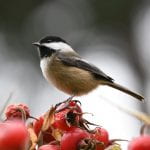
As you continue your hike, try to identify birds. Many species of birds do not migrate but remain to take advantage of local food sources. Some of these birds, especially chickadees, can spend the winters here in the northeast due to their short-term hibernation state called ‘torpor,’ which they enter when temperatures drop. During this period triggered by exposure to cold, food shortages, or droughts, their energy expenditure is reduced. Throughout their torpor, metabolism, body temperature, and heart rate are decreased to help them conserve energy and maintain body heat.
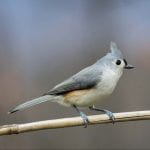
On some winter days, you may find chickadees and other birds perched in a tree, flying over an open field, or even snacking at your backyard feeder. Some birds you may see on a Hudson Valley winter hike include the black-capped chickadee, northern cardinal, tufted titmouse, American tree sparrow, dark-eyed junco, various woodpeckers (i.e. downy, pileated, etc.), and raptors (i.e. owls and hawks).
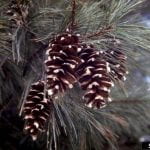
There are also many trees that thrive in the forests in the winter and are relatively easy to identify. The native eastern white pine (Pinus strobus) is found in well-drained soils, and usually grows straight and tall with horizontal, upturned branches. The tree has a uniformly full foliage, with a light gray bark that has shallow ridges. White pines have 5 feathery light green needles per cluster, and both the needles and the stem are flexible and slim. White pine cones, which are narrow and about 3 to 8 inches long, are tasty treats for squirrels and birds.
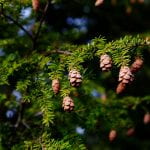
Another native evergreen, the eastern hemlock (Tsuga canadensis), has a tall, straight growth pattern, with branches that stretch out horizontally. It looks like a Christmas tree covered in small, round, brown pine cone decorations. Unlike Christmas pine trees, though, hemlock does not have bundles of needles, just one short needle per node. The needles are soft and dark green in color with two ‘racing stripes’ on the underside of each needle. Its twigs are thin and flexible. The bark of the Hemlock is scaly when young, and eventually becomes ridged with age. Its trunk is reddish-brown in color. These trees grow in a shady, moist habitat, along streams or at higher elevations, and help keep the water in mountain streams cold for brook trout and other coldwater fishes.
Many of NYS’s hiking trails offer fragrant pine and evergreen forests. Taking in the scents and tranquil beauty of these trails can do much to calm your spirits during difficult times. Observe the striking contrast of the greenery against any snow that may have fallen. Stop and admire stands of birch surrounding frozen lake and creek shorelines, and the astonishing views that have opened up since the autumn leaves have fallen. In addition to the stark majesty of the forest’s bare branches against the winter sky, remember to keep an eye out for the Hudson Valley’s many waterfalls, which are even more magnificent when temperatures drop below freezing. What could be more magical than icicle-glistening waterfalls?

One final interesting attraction I’ll mention that you might encounter in a local forest hike is the flat-branched tree clubmoss (Lycopodium obscurum), also called ‘ground pine’ (although it really is a moss). It is fairly common here in the eastern US and southeastern Canada. Clubmosses look like miniature Christmas trees or candles on the forest floor. Some types grow as long runners that were once commonly used for garlands. Today, this plant is on the protected species list in order to prevent over-harvesting. So if you do get the chance to see some, please enjoy the sight and then let it be!
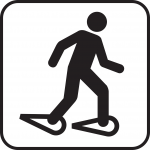 Besides walking, there are many other ways to explore local hiking trails. Depending on the amount of snow cover, some good alternatives to hoofing it in boots alone include donning snowshoes or cross-country skis.
Besides walking, there are many other ways to explore local hiking trails. Depending on the amount of snow cover, some good alternatives to hoofing it in boots alone include donning snowshoes or cross-country skis.
The Hudson Valley has an abundance of state parks and outdoor recreation areas to visit. Here are some suggested destinations for lovely winter treks:
Hudson Highlands State Park Preserve
Arden Point and Glenclyffe
Garrison
A woody road leads to a blue-blazed trail that takes you to Arden Point, the first of several vistas on this easy four-mile hike. In addition, the walk takes you over a road used by noted Revolutionary War–era figure Benedict Arnold to escape capture after being revealed as a traitor.
Sterling Forest State Park
Townsend Trail and Long Meadow Extension Loop
Southfields
Take the green-on-orange Townsend Trail to the white-on-green Long Meadow Extension Trail, which is also a skiing trail. The sweeping view overlooking southeast Orange County is made even more expansive thanks to the bare trees of winter.
Heritage Trail (Orange County)
Follow the former Erie Railroad as it winds past historic graveyards, onion farms, a wildlife sanctuary, and the villages of Monroe, Chester, and Goshen.
Minnewaska State Park Preserve (Ulster County)
Kerhonkson
Stroll around the lake and watch for hawks flying down below as you navigate steep carriage trails lined with craggy rocks.
Mohonk Mountain House
New Paltz
Designated a National Historic Landmark in 1986, this resort sits on 2200 acres of landscaped meadows, adjacent to the Mohonk Preserve—an 8000-acre expanse of mountain terrain. Forty miles of hiking trails through forests, cliffs, streams, and ponds provide cascading views of the Catskills.
Black Rock Forest
Cornwall
Explore a great variety of trails, from carriage-type roads to narrow, rocky paths. The many reservoirs and ecosystems and the tree and plant diversity offer good opportunities to see wildlife, or at least their tracks!
Hudson Highlands Nature Museum
Cornwall
Cornwall’s many hiking trails along meadows, forests, and ponds make for a winter wonderland.
Finally, for a plethora of further information on where to go and what you’ll find, safety tips, suggested trails to hike based on your level of experience, helpful links, and much more, visit the Hiking page on the NYS Department of Environmental Conservation website.
So, loaded up with good information and the right preparations and equipment, you can get out there and enjoy the great outdoors in the winter. Just remember, “There’s no such thing as bad weather, only bad clothes!”
